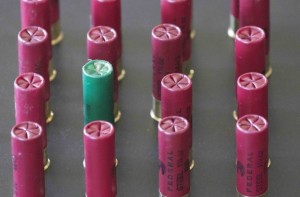With the return of marine mammals and migratory birds to the Bering Straits region, subsistence hunters are still struggling to find certain kinds of ammunition.
Are you having trouble getting ammo? Well, you’re not alone.
With the return of marine mammals and migratory birds to the Bering Straits region, subsistence hunters are still struggling to find certain kinds of ammunition.

There are several popular calibers they still can’t get in stock at the Native Store in Gambell.
“The .300’s–.303, 2-.22’s, .243, I think,” said assistant manager Julian Apataki last month.
Mary Ungut manages the store and said not only are bullets used hunting seal, ugruk, and other animals hard to get, but they’re more expensive.
“We’ve also been having a hard time getting some .22 shells,” she explained. “It seems that the price is increasing, too.”
Gambell is hardly the only place in Alaska where it’s hard to get .22 bullets. A recent article in the Alaska Dispatch described bare shelves and early morning lines outside Anchorage stores to snag boxes the day shipments arrive. That demand downstate has created a choke point for supplying rural communities where ammo is an essential tool for subsistence.
“If we were to get, say, 30 cases of that .22 ammo—basically what we’d have to do with the 40 stores that have ordered it is we’d divide it amongst the stores. Or, if there was less, we’d divide it based on the need at the time,” said Bill Willaims, manager of distribution for ANICA, the Alaska Native Industries Cooperative Association. The company supplies 40 native stores from the Aleutians to Kaktovik, including the one in Gambell. Part of Williams’ job is to anticipate inventory needs around the subsistence calendar, and ship the right bullets at the right time.
“We would prioritize the subsistence needs,” Williams continued, “if people are ugruk hunting and we have .223 ammo in and don’t have enough for everybody—it would go to the people that are hunting ugruks at the time. So that’s basically how we delegate it out.”
Williams has had to venture beyond his Anchorage distributors and down to Washington state for bullets bound for village stores. Rural communities are getting hit with the tail end of a shortage created after the Sandy Hook shootings in December 2012, which sparked national ammo runs and stockpiling. But because ANICA, like many other rural retailers, places bulk orders months in advance, there was a buffer.
“Two years ago we still had an order coming when all the stores in Anchorage ran out of ammunition. So we did have an insulation because we did have a big shipment of ammo coming in,” Williams said. But after the following summer and into this year inventories were almost totally depleted. “This spring has been really bad. But it’s starting to come back around.”
The shortage is easing, if not disappearing completely. Shotgun shells, .223’s, and other common calibers for subsistence are back on shelves in Nome and Gambell. But higher prices, rationing, and waiting periods have rural hunters wondering if this is the new normal for ammo.
The cause of the ammo shortages in the Lower 48 trickling up through Anchorage and finally to the Bush has been the widely speculated on, with explanations ranging from worries about gun regulation to government stockpiling.
Last winter the NRA’s official magazine, American Rifleman, released a comprehensive and well researched article on what was causing the shortage. In short, lots of people ran out to buy lots of ammo on top of a five year rise in demand not matched by increased production. Based on taxes collected on ammo purchases, the amount of ammunition purchased from 2007 to 2012 doubled. Once the Sandy Hook school shooting raised a panic among gun owners, second amendment proponents, stockpilers and profiteers, rapid runs on already exhausted inventories depleted the supply chain.
Zachariah Hughes reports on city & state politics, arts & culture, drugs, and military affairs in Anchorage and South Central Alaska.
@ZachHughesAK About Zachariah




